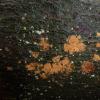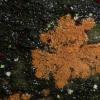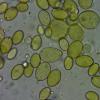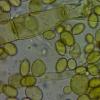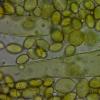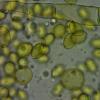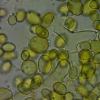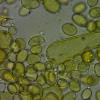
24-12-2025 17:08
Hulda Caroline HolteHello, I have found this propoloid ascomycete on

21-12-2025 09:32
Hello.A tiny ascomycete found embedded in wood in

21-12-2025 21:32
Pol DebaenstHello, Garden, Burgweg 19, Veurne, BelgiumOn 10/1

22-12-2025 23:38
Patrice TANCHAUDBonsoir, récolte sur un mur en pierre, apothéci

22-12-2025 00:47
Patrice TANCHAUDBonsoir, récolte à proximité du milieu dunaire

... collected in the National Park of Eifel, Germany, 13.11.19, on very freshly fallen log of Fagus sylvatica, on the bark (iniatial phase), abundantly growing.
The conidia are very variable in size, about (12)14-18(21)/(7,5)9-13(17) µm, the hyphae are about 14-18 µm broad, at the clavate ends up to 23 µm.
I think of an anamorph of Botryobasidium, but I do not clearly get to a species. Does somebody?
Best regards, Lothar
See for instance: http://www.bioref.lastdragon.org/Chlorophyta/Trentepohlia.html
Eduard

Hello Eduard,
thank you for your proposal.
But - I do not believe this. I saw Trentepohlia often, on rocks and on wood also. I am sure this is a fungus.
Best regards, Lothar
compare with Nematogonum ferrugineum.
Viele Grüße,
Thorben

Hallo Thorben,
fantastisch - das scheint sehr gut zu passen.
Ich habe mich hier informiert:
http://www.ascofrance.com/forum/13380/asco-sur-fagus
Wenn ich es richtig verstanden habe, handelt es sich um einen Parasiten auf Neonectria-Arten. In der Nähe sah ich N. coccinea (oder was ich dafür halte), insofern passt es vorzüglich, natürlich auch bezüglich der makro- und mikroskopischen Merkmale.
Nochmals danke und herzliche Grüße
Lothar
